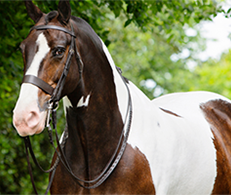
Confusing horsey terms explained
Are you new to the equine world and struggling to keep up with the conversation in the tack room? Take a look at our jargon-busting guide for the funny, interesting and simply horsey terms we equestrians use.
Horsey terminology can be confusing to the untrained ear. If you’re new to the equine world, and struggling to make sense of some of the phrases you hear, we’ve demystified a list of common horsey terms.
What is a cob?
If you live in parts of the Midlands or the north of England, a cob refers to a bread roll – anywhere else and your first thought is probably corn on the cob. However, if someone suggests you admire a cob in the horse world, they’re not pointing out a tasty sandwich. They’re talking about a type of horse in the same way you get types of dog, such as a lurcher or terrier. Cobs tend to be stocky and strong – very different from a thoroughbred racehorse. They make good leisure horses and compete successfully in a variety of disciplines.
How big is a hand?
It depends how big the owner is, surely? Yes, if you’re talking about human hands, but a hand is also the traditional form of measurement used to determine a horse’s height. One hand is equivalent to four inches, so if a horse is described as 15.2hh (said as 15-2 hands), this means they are 15 x 4 inches, plus another two – 62 inches. Horses are measured to the wither, which is similar to the top of our shoulder.
What is a horse’s frog?
Rather than the lively amphibian we often find in our garden ponds, a frog in the horse world is part of a horse’s foot. If you were to lift a horse’s hoof to see underneath, you would notice that part of the sole is raised, soft and triangular in shape. This is known as the frog, and it helps with blood circulation, shock absorption and traction.
What is a green horse?
Rather than describing the coat colour of a grey horse after it’s been rolling around in the grass, green refers to the horse’s level of experience. A green horse is usually young and inexperienced under saddle. It’s advisable that green horses are handled by experienced equestrians to ensure their training is safe and consistent.
What is a spooky horse?
Not to be confused with a horse under a white sheet on Halloween, a horse described as spooky has had their flight response activated because something has caused them to feel unsafe. It could be something like a plastic bag in a hedge that causes a horse to ‘spook’ – they might jump to the side in surprise, for example. Some horses are more ‘spooky’ than others and are known for being more easily startled.
What is a fresh horse?
You might think someone is referring to their horse being recently bathed if they describe them as fresh, but while this may well be the case, what they actually mean is that their horse is feeling full of energy and ready to go. This could be because they haven’t been ridden or handled in a while, and it usually means the rider will need to spend a bit longer warming up and settling the horse before they start work.
How do you lunge a horse?
If someone asked you to lunge, your mind might automatically switch back to warming up for PE at school or a gym session, but when talking about lunging horses, equestrians aren’t referring to making their horses stretch their quads and hamstrings by splitting their legs in a lunge stance. Lunging a horse is a form of exercise where the handler stands in the middle of a training space and has the horse on a long line, moving around them in a circle. Equestrians might lunge their horse for additional exercise, if they were fresh or as part of a rehab programme.
What is a good-doer?
While horses can be described as honest and genuine, they aren’t known for doing good deeds off their own back. A good-doer is a horse that survives, thrives and does well off very little food. People often say their horse ‘lives off fresh air’ or ‘only needs to sniff his dinner to gain weight’ – these horses are good-doers. In contrast, a poor-doer needs to eat a lot more to maintain their weight and condition.
Have you learnt any strange equestrian terms that sounded a bit odd at first? Tell us on Facebook!


